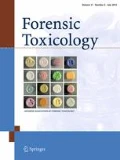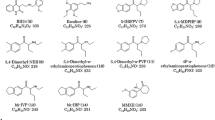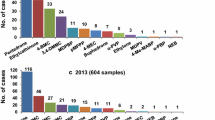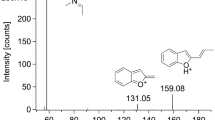Abstract
β-Keto derivatives of 3,4-methylenedioxyphenylalkylamines (bk-MDPAs), especially 2-methylamino-1-(3,4-methylenedioxyphenyl)propan-1-one (methylone), 2-methylamino-1-(3,4-methylenedioxyphenyl)butan-1-one (bk-MBDB), and 2-ethylamino-1-(3,4-methylenedioxyphenyl)propan-1-one (bk-MDEA), are abused as substitutes for 3,4-methylenedioxyphenylalkylamines in some countries, causing increased social problems. With the widespread abuse of bk-MDPAs, the analysis of bk-MDPAs and their metabolites in human specimens is quite important in forensic and clinical toxicology. In this review, the metabolisms of bk-MDPAs and simultaneous analytical methods for bk-MDPAs and their metabolites by gas chromatography–mass spectrometry, liquid chromatography–mass spectrometry, and liquid chromatography–tandem mass spectrometry are presented.









Similar content being viewed by others
References
Shulgin AT (1978) Psychotomimetic drugs: structure–activity relationships. In: Iversen LL, Iversen SD, Snyder SH (eds) The handbook of psychopharmacology: stimulants, vol 11. Plenum, New York, pp 243–333
Buchanan JF, Brown CR (1988) ‘Designer Drugs’ a problem in clinical toxicology. Med Toxicol Adverse Drug Exp 3:1–17
Glennon RA (1989) Stimulus properties of hallucinogenic phenylalkylamines and related designer drugs: formulation of structure–activity relationships. In: Asghar K, Souza ED (eds) Pharmacology and toxicology of amphetamine and related designer drugs. NIDA Research Monograph 94, Superintendent of Documents, U.S. Government Printing Office, Washington D.C., pp 43–67
Dal Cason TA, Young R, Glennon RA (1997) Cathinone: an investigation of several N-alkyl and methylenedioxy-substituted analogues. Pharmacol Biochem Behav 58:1109–1116
Parker MA, Marona-Lewicka D, Lucaites VL, Nelson DL, Nichols DE (1998) A novel (benzodifuranyl)aminoalkane with extremely potent activity at the 5-HT2A receptor. J Med Chem 41:5148–5149
Uchiyama N, Kikura-Hanajiri R, Kawahara N, Goda Y (2009) Identification of a cannabimimetic indole as a designer drug in a herbal product. Forensic Toxicol 27:61–66
Kamata T, Katagi M, Tsuchihashi H (2010) Metabolism and toxicological analyses of hallucinogenic tryptamine analogues being abused in Japan. Forensic Toxicol 28:1–8
Zaitsu K, Katagi M, Kamata H, Nakanishi K, Shima N, Kamata T, Nishioka H, Miki A, Tatsuno M, Tsuchihashi H (2010) Simultaneous analysis of six novel hallucinogenic (tetrahydrobenzodifuranyl)aminoalkanes (FLYs) and (benzodifuranyl)aminoalkanes (DragonFLYs) by GC-MS, LC-MS, and LC-MS-MS. Forensic Toxicol 28:9–18
Vardakou I, Pistos C, Spiliopoulou Ch (2010) Spice drugs as a new trend: mode of action, identification and legislation. Toxicol Lett 197:157–162
Jacob P, Shulgin AT (1996) Preparation of novel N-substituted-2-amino-3′,4′-methylenedioxypropiophenones as anti-depressant and anti-parkinsonism agents. PCT International Applications, p 19
Cozzi NV, Sievert MK, Shulgin AT, Jacob P, Ruoho AE (1998) Methcathinone and 2-methylamino-1-(3,4-methylenedioxyphenyl)propan-1-one (methylone) selectively inhibit plasma membrane catecholamine-reuptake transporters. Soc Neurosci Abstr 24:381–388
Cozzi NV, Sievert MK, Shulgin AT, Jacob P (1999) Inhibition of plasma membrane monoamine transporters by β-ketoamphetamines. Eur J Pharmacol 381:63–69
Bossong MG, Van Dijk JP, Niesink RJ (2005) Methylone and mCPP, two new drugs of abuse? Addict Biol 10:321–323
Erowid (2010) The vaults of Erowid. http://www.erowid.org/chemicals/methylone/methylone_info1.shtml. Accessed Dec 2010
Russell M, Sibley J, Bunyan J (2010) Methylone found in New Zealand party pills. TIAFT Bull 40:38–39
Kamata HT, Shima N, Zaitsu K, Kamata T, Miki A, Nishikawa M, Katagi M, Tsuchihashi H (2006) Metabolism of recently encountered designer drug, methylone, in humans and rats. Xenobiotica 36:709–723
Zaitsu K, Katagi M, Kamata HT, Kamata T, Shima N, Miki A, Tsuchihashi H, Mori Y (2009) Determination of the metabolites of new designer drugs bk-MBDB and bk-MDEA in human urine. Forensic Sci Int 188:131–139
Meyer MR, Wilhelm J, Peters FT, Maurer HH (2010) Beta-keto amphetamines: studies on the metabolism of the designer drug mephedrone and toxicological detection of mephedrone, butylone, and methylone in urine using gas chromatography-mass spectrometry. Anal Bioanal Chem 397:1225–1233
Springer D, Fritschi G, Maurer HH (2003) Metabolism and toxicological detection of the new designer drug 3′,4′-methylenedioxy-alpha-pyrrolidinopropiophenone studied in urine using gas chromatography-mass spectrometry. J Chromatogr B 793:377–388
Testa B, Beckett AH (1973) Metabolism and excretion of diethylpropion in man under acidic urine conditions. J Pharm Pharmacol 25:119–124
Milhailova M, Rosen A, Testa B, Beckett AH (1974) A pharmacokinetic investigation of distribution and elimination of diethylpropion and its metabolites in man. J Pharm Pharmacol 26:711–721
Brenneison R, Mathys K, Geisshusler S (1991) Determination of S-(−)-cathinone and its main metabolites R, S-(−)-norephedrine in human plasma by high-performance liquid chromatography and photodiode array detection. J Liq Chromatogr 14:271–286
Paul BD, Cole KA (2001) Cathinone (Khat) and methcathinone (CAT) in urine specimens. J Anal Toxicol 25:525–530
Toennes SW, Kauert GF (2002) Excretion and detection of cathinone, cathine, and phenylpropanolamine in urine after kath chewing. Clin Chem 48:1715–1719
Lim HK, Foltz RL (1989) Identification of metabolites of 3,4-(methylenedioxy)-methamphetamine in human urine. Chem Res Toxicol 2:142–143
de la Torre R, Farré M, Roset PN, Pizarro N, Abanades S, Segura M, Segura J, Camí J (2004) Human pharmacology of MDMA pharmacokinetics, metabolism, and disposition. Ther Drug Monit 26:137–144
Kamata HT, Shima N, Zaitsu K, Kamata T, Nishikawa M, Katagi M, Miki A, Tsuchihashi H (2007) Simultaneous analysis of new designer drug, methylone and its metabolites in urine by gas chromatography-mass spectrometry and liquid chromatography-electrospray ionization mass spectrometry. Jpn J Forensic Sci Technol 12:97–106
Shima N, Tsutsumi H, Kamata T, Nishikawa M, Katagi M, Miki A, Tsuchihashi H (2006) Direct determination of glucuronide and sulfate of p-hydroxymethamphetamine in methamphetamine users’ urine. J Chromatogr B 830:64–70
Shima N, Kamata H, Katagi M, Tsuchihashi H, Sakuma T, Nemoto N (2007) Direct determination of glucuronide and sulfate of 4-hydroxy-3-methoxymethamphetamine, the main metabolite of MDMA, in human urine. J Chromatogr B 857:123–129
Berrang BD, Lewin AH, Ivy CF (1982) Enantiomeric α-aminopropiophenones (cathinone): preparation and investigation. J Org Chem 47:2643–2647
Togawa Y, Ohmori T, Tanaka K, Inoue T (1994) Analyses of new stimulants, methcathinone and cathinone. Rep Natl Res Inst Police Sci 47:77–84 (in Japanese with English abstract)
Zaitsu K, Katagi M, Kamata HT, Miki A, Tsuchihashi H (2008) Discrimination and identification of regioisomeric β-keto analogues of 3,4-methylenedioxyamphetamines by gas chromatography-mass spectrometry. Forensic Toxicol 26:45–51
Zaitsu K, Katagi M, Kamata T, Kamata H, Shima N, Tsuchihashi H, Hayashi T, Kuroki H, Matoba R (2008) Determination of a newly encountered designer drug “p-methoxyethylamphetamine” and its metabolites in human urine. Forensic Sci Int 177:77–84
Zaitsu K, Katagi M, Kamata H, Kamata T, Shima N, Miki A, Iwamura T, Tsuchihashi H (2008) Discrimination and identification of the six aromatic positional isomers of trimethoxyamphetamine (TMA) by gas chromatography-mass spectrometry (GC-MS). J Mass Spectrom 43:528–534
Kanai K, Takekawa K, Kumamoto T, Ishikawa T, Ohmori T (2008) Simultaneous analysis of six phenethylamine-type designer drugs by TLC, LC-MS, and GC-MS. Forensic Toxicol 26:6–12
Kudo K, Ishida T, Hikiji W, Hayashida M, Uekusa K, Usumoto Y, Tsuji A, Ikeda N (2009) Construction of calibration-locking databases for rapid and reliable drug screening by gas chromatography-mass spectrometry. Forensic Toxicol 27:21–31
Kudo K, Ishida T, Hikiji W, Usumoto Y, Umehara T, Nagamatsu K, Tsuji A, Ikeda N (2010) Pattern of poisoning in Japan: selection of drugs and poisons for systematic toxicological analysis. Forensic Toxicol 28:25–32
Morita M, Ando H (1983) Analysis of methamphetamine and its metabolites in urine from a habitual user of the stimulant. EISEI KAGAKU 29:318–322 (in Japanese with English abstract)
Maurer HH (2005) Advances in analytical toxicology: the current role of liquid chromatography–mass spectrometry in drug quantification in blood and oral fluid. Anal Bioanal Chem 381:110–118
Mueller CA, Weinmann W, Dresen S, Schreiber A, Gergov M (2005) Development of a multi-target screening analysis for 301 drugs using a QTrap liquid chromatography/tandem mass spectrometry system and automated library searching. Rapid Commun Mass Spectrom 19:1332–1338
Dresen S, Kempf J, Weinmann W (2006) Electrospray-ionization MS/MS library of drugs as database for method development and drug identification. Forensic Sci Int 161:86–91
Smith ML, Vorce SP, Holler JM, Shimomura E, Magluilo J, Jacobs AJ, Huestis MA (2007) Modern instrumental methods in forensic toxicology. J Anal Toxicol 31:237–253
Katagi M, Zaitsu K, Shima N, Kamata H, Kamata T, Nakanishi K, Nishioka H, Miki A, Tsuchihashi H (2010) Metabolism and forensic toxicological analyses of the extensively abused designer drug methylone. TIAFT Bull 40:30–34
Author information
Authors and Affiliations
Corresponding author
Rights and permissions
About this article
Cite this article
Zaitsu, K., Katagi, M., Tatsuno, M. et al. Recently abused β-keto derivatives of 3,4-methylenedioxyphenylalkylamines: a review of their metabolisms and toxicological analysis. Forensic Toxicol 29, 73–84 (2011). https://doi.org/10.1007/s11419-011-0111-8
Received:
Accepted:
Published:
Issue Date:
DOI: https://doi.org/10.1007/s11419-011-0111-8




